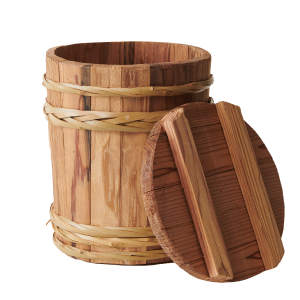a wish for continuation in miso making


 ──About how many craftsmen like Mr. Hisada still exist in Japan?
──About how many craftsmen like Mr. Hisada still exist in Japan?
Hisada : About 10 workshops nationwide. It seems as many places are going out of business. Because of that, I have started receiving orders from places far away as well.
Especially places that are mechanized costs much and their business becomes hard to manage. Doing business on my own by myself is how I get by.
 ──Handmade buckets and barrels by a craftsman might be something that would be hard to obtain from now on. By the way, what kind of demands are there recently?
──Handmade buckets and barrels by a craftsman might be something that would be hard to obtain from now on. By the way, what kind of demands are there recently?
Hisada : Lately, it’s been used by period drama series on TV. The handmade appearance seems to appeal more than a machine-made one. Others include chairs for restaurants or items for souvenir shops.
──So there is a demand for production work other than using it as containers.Hisada : There used to be demand for sake barrels to be used for election ceremonies or festivals but that has decreased greatly.
The real purpose of a barrel is that what's inside doesn’t leak, so when I receive orders to be used as a container, I do feel motivated.
 ──Tarutou Youki Kougyousyo and Noda Miso have done business in the past.
──Tarutou Youki Kougyousyo and Noda Miso have done business in the past.
Noda : Yes from my father’s generation.
Hisada : Yes, I’ve also heard from before I was born.
Noda : Well, there has been reckless requests since it has become my generation. lol.
Just recently, I had an idea inspired by a whiskey barrel I saw in Ireland and wanted to make a container to mature the liquid called ‘’tamari’ that is extracted in the process of making miso, using Japanese wood and wood container techniques and Mr. Hisada was great in making it happen.

Hisada : Yes, that one was a hard task. lol.
──With the start of otemae, I have frequently done business with Mr. Noda but in the original sense, our businesses only happen once in a few years. Wood buckets for miso are durable and last for a very long time.
Noda : Yes exactly. My warehouse has wooden barrels that have been used for a hundred years and it still works fine.
 ──Tools that lasts for a long time is a great thing, but it must be a little dilemma for craftsmen.
──Tools that lasts for a long time is a great thing, but it must be a little dilemma for craftsmen.
Hisada : Well actually, if you don’t use the wood barrels and leave it as is, it breaks easily.
Noda : On the other hand, it lasts for a long time when used properly.
Hisada : The wood stretches out by absorbing moisture from what's kept inside the barrel and the hoop binds it together to keep it in place, so when you don’t use the bucket and it dries out, the wood shrinks and the hoop comes off, breaking it as a result.
──That is why it’s important to soak it in water before you first place miso in a wooden barrel. When I tried it for the first time, water leaked in the beginning and I was a little uneasy but I was surprised how it stopped leaking the next day.Hisada : The wood is dry and creates little cracks before use so it’s unavoidable in the beginning.
 ──By the way, what’s the difference between taru and oke?
──By the way, what’s the difference between taru and oke?Hisada : An easy explanation is that taru is sealed to carry or store what’s inside but oke does not have a lid so the top is normally open. On top of that, oke craftsmen are further divided into smaller divisions such as sushi oke, bathtub and or ohitsu which is a wood bucket for cooked rice.
──So there is a big difference between the two.Hisada : Yes, there is. To tell you the truth, people don’t really differentiate between calling taru or oke. We do call the big wooden taru at Noda Miso oke sometimes and people have different understandings of the difference.
 ──A small wood bucket was created in collaboration with otemae as ‘Craftsmen’s craft wood bucket’ to be used at home for preparing miso traditionally. How was this experience?
──A small wood bucket was created in collaboration with otemae as ‘Craftsmen’s craft wood bucket’ to be used at home for preparing miso traditionally. How was this experience?
Hisada : It was a very hard task as it is harder to make when the sizes are smaller. What we’ve made this time was for 2~4 liters but usually the smallest size we make is 5.4 liters so I don’t think there are a lot of barrel craftsmen that can make this. Fortunately, it was a very challenging project and I had fun being involved.
──How long does it take to make one?Hisada : I can make about three or four buckets a day.
──It would become difficult if there is a huge order.Hisada : Since its off-scale, it takes up a lot of time than usual.
 ──With otemae, we are very particular with the ingredients so I am very grateful that we were able to create tools with the same enthusiasm and my requests being met. By the way, why is it made from cedar wood?
──With otemae, we are very particular with the ingredients so I am very grateful that we were able to create tools with the same enthusiasm and my requests being met. By the way, why is it made from cedar wood?
Hisada : In Japan, other options will be included cypress, which has a strong aroma. Cedar does not have that problem and since it grows straight up it’s very easy to handle. We purchase it from the timber market in Kiso or Gero area.

Craftsmen’s craft wooden container
(size 2kg)
Buy from Here

Craftsmen’s craft wooden container
(size 4kg)
Buy from Here

Craftsmen’s craft wooden container
(size 8kg)
Buy from Here
 ──What message do you want to convey to the people who are already using the wood bucket and for people that are about to start?
──What message do you want to convey to the people who are already using the wood bucket and for people that are about to start?
Hisada : Tools from the old times are not meant to be replaced after several uses but meant to be used until the end. It will change in color and it will develop certain ease of use so I hope it will be used repeatedly. It will last for 50 to 70 years without any problems.
──There aren’t’t a lot of tools that can be used for 50 years….!Hisada : If it breaks, I will be more than happy to take a look. Some people say “Let me know if it's unrepairable” when they bring it in the workshop but a lot of times it could be fixed easily. So my wish is that people continue preparing miso with one wood bucket for at least 50 years.
Noda : Talking from a miso professional prospective, the more times miso is prepared in a wooden bucket, the more favorable microbes in fermenting and maturing will reside, which will bring out the better aroma and deeper flavor to the miso. Plastic containers are not that way, so I do wish that miso to be aged in wooden buckets.
Hisada : It will be to use it for its full purpose until the end. There are three things that many households did in the old times. It is to prepare otsukemono (pickled vegetables) or miso in wood buckets, sharpen knives, and planning wooden cutting boards. Taking care of tools leads to using it for a long time and my recommendation personally is to sharpen knives. It’s very interesting and I wish for people who make miso to give it a try.











